Another School Shooting – A Three Part Series on the Five Major Causes of Mass Murder in America : A Well Thought Out Scream by James Riordan
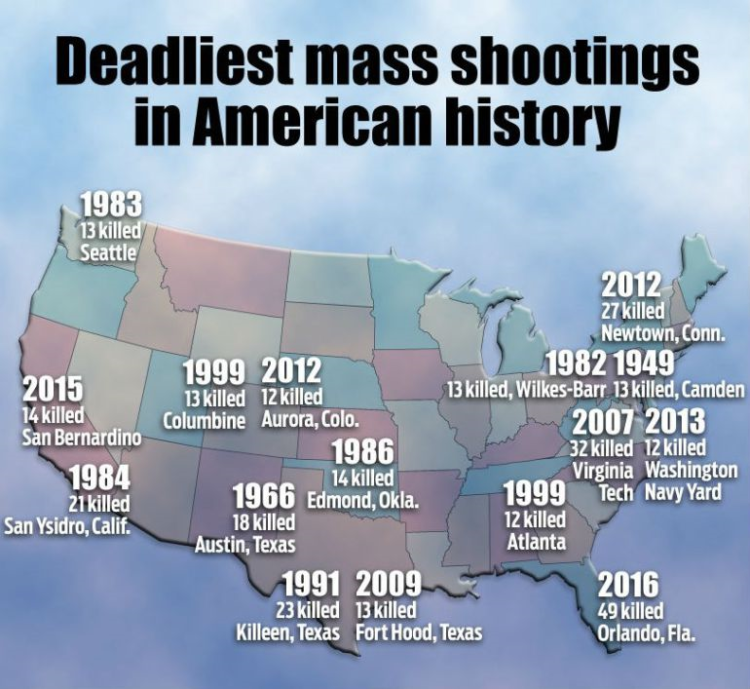
PART ONE : It’s Guns, but not just guns
This past week saw another horrible school shooting, this one is Santa Fey, Texas. where a teenage boy shot and killed eight students and two teachers at a Houston-area high The Friday attack, which also wounded another thirteen, echoed the all-too-familiar horrors Americans are accustomed to seeing on the news. The gunman, Dimitrios Pagourtzis, 17, who was a student at Santa Fe High School, used two firearms: a shotgun and .38 caliber revolver, both of which he got from his father. Students  were just starting their day in the first-period art class when it turned into a war zone. The rampage occurred entirely within the art complex at the high school with the gunman barricading himself inside from the hail of police officers’ bullets that followed him there. Law enforcement received the first calls at 7:32 a.m. CT, . It wasn’t until 30 minutes later that Pagourtzis would surrender and admit to targeting students he didn’t like inside the school, authorities said.
were just starting their day in the first-period art class when it turned into a war zone. The rampage occurred entirely within the art complex at the high school with the gunman barricading himself inside from the hail of police officers’ bullets that followed him there. Law enforcement received the first calls at 7:32 a.m. CT, . It wasn’t until 30 minutes later that Pagourtzis would surrender and admit to targeting students he didn’t like inside the school, authorities said.
Accused Texas school shooter Dimitrios Pagourtzis
Authorities recovered a couple of explosive devices at the school and “several” in Pagourtzis’ vehicle and home, McCaul said, and they’ve been sent for testing to the FBI laboratory in Quantico, Va. It’s still unclear whether any of the devices were used in the shooting.
The motive may have included romantic rejection. Sadie Rodriguez, the mother of Shana Fisher, 16, said that her daughter spurned four months of aggressive advances from Pagourtzis. Fisher finally stood up to him and embarrassed him in class, her mother said in a private message to the L.A. Times. “A week later he opens fire on everyone he didn’t like,” she said. “Shana being the first one.” If true, it would be the second school shooting in recent months driven by such rejection. In March, a 17-year-old Maryland high school student used his father’s gun to fatally shoot a female student with whom he had been in a recently ended relationship.
Zachary Muehe, a sophomore at the school of roughly 1,400 students, was in one of the rooms in the art complex when he heard three loud booms. Muehe told The New York Times that he recognized Pagourtzis from the school’s football team — then he realized the teen was holding a shotgun. “It was crazy watching him shoot and then pump. I remember seeing the shrapnel from the tables, whatever he hit. I remember seeing the shrapnel go past my face,” he told the Times. As he ran from the classroom, he told the newspaper he looked back and saw students lying on the ground. “There was a girl on the ground, and he shot her in the head one or two times,” he said.
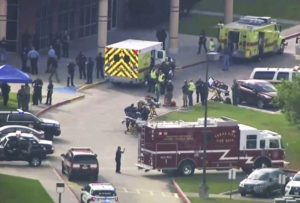 The first one to confront Pagourtzis was one of the school’s police officers, John Barnes, who tried entering the art complex looking for the shooter, Galveston County Judge Mark Henry said. But Pagourtzis appeared to be ready for Barnes and fired at him, hitting him in the upper arm. As of Saturday afternoon, Barnes was in stable but critical condition at University of Texas Medical Branch in Galveston. “He was going to try to neutralize the shooter and the shooter was waiting for him,” Henry said.
The first one to confront Pagourtzis was one of the school’s police officers, John Barnes, who tried entering the art complex looking for the shooter, Galveston County Judge Mark Henry said. But Pagourtzis appeared to be ready for Barnes and fired at him, hitting him in the upper arm. As of Saturday afternoon, Barnes was in stable but critical condition at University of Texas Medical Branch in Galveston. “He was going to try to neutralize the shooter and the shooter was waiting for him,” Henry said.
As the shooting unfolded in the art complex, students and teachers in other parts of the school braced for the shooter or fled the scene. Kaylee Haaga, 17, was just settling into Steve Rose’s first-period economics class when a person in the hall outside told Rose that someone had a shotgun in the school. The teacher immediately closed the door, ordered all the students to hide under their desks and crouched next to the door, waiting to jump on the shooter if he came in, Haaga said. Haaga hid under Rose’s desk and pulled a chair over the opening. She texted her mom and dad and frantically tried to reach her little sister, Shelby, 15, a freshman at Santa Fe High.
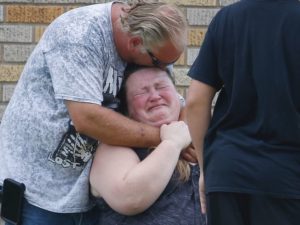 After a while, she put her phone away. “I already told the people I love that I loved them,” she said. Later, police officers entered her class and told the students to move out. The halls were filled with officers in tactical gear armed, searching classrooms and closets. One of the officers instructed Haaga and her classmates to go out to the front of the school, rather than the back, she said. “He told me if you hear any shots, run as fast as you can,” Haaga said. “Soon as you get out those doors, take your shoes off, run to the other side and don’t look back.”
After a while, she put her phone away. “I already told the people I love that I loved them,” she said. Later, police officers entered her class and told the students to move out. The halls were filled with officers in tactical gear armed, searching classrooms and closets. One of the officers instructed Haaga and her classmates to go out to the front of the school, rather than the back, she said. “He told me if you hear any shots, run as fast as you can,” Haaga said. “Soon as you get out those doors, take your shoes off, run to the other side and don’t look back.”
She did just that. Inside the art complex, Pagourtzis roamed from room to room, taunting students and shooting at them as they scrambled behind desks or hid in closets. When a group of students hid in a supply closet, the shooter yelled “Surprise!” followed by an expletive, and opened fire, killing two of the eight students hiding in there, according to a Facebook post by Deedra Van Ness, whose daughter, Isabelle, survived the ordeal. “She and her friends had been in the same room with the gunman the entire time,” Van Ness wrote.
Not until 8:02 a.m. — 30 minutes after the shooting started — did Pagourtzis exit one of the art classrooms and fall to the ground and surrender in an apparent hope of avoiding a police confrontation. “Our officers went in there and did what they could,” Walter Braun, Santa Fe school district police chief, said Saturday. “They did what they’re trained for and went in immediately.”
Authorities recovered a couple of explosive devices at the school and “several” in Pagourtzis’ vehicle and home, McCaul said, and they’ve been sent for testing to the FBI laboratory in Quantico, Va. It’s still unclear whether any of the devices were used in the shooting.
People gather May 18, 2018, outside Barnett Intermediate School, where parents gathered to pick up their children following a shooting at Santa Fe High School.
In America, in 2018, mass murder has become a “fight back fantasy” that frequently occurs as a possible last result for many who struggle to cope with each new day, finding themselves sinking further and further into the quagmire of modern economics with not only no way out, but no way to even express their problem. The sufferer eventually loses all hope of recovery and begins focusing primarily on a way not to go down without a whimper. The need for what he or she sees as “righteous recognition” becomes the driving force of the individual until he or she perceives a way to publically shout their pain in a voice that cannot be ignored. The greater the pressurized pain, the greater the release, the more public the event and the more suffering it must release.
After much detailed research for a book I am writing entitled Ready to Pop : The Rise of Mass Murder in America, I have come to the conclusion that there are five factors in America today which have combined into a perfect storm to fuel mass murder including school shootings. A single factor applies to a greater or lesser degree depending upon the age of the shooter. These factors are : Access to Guns, Familiarity with Violence, The Pressure of Consumerism, Lack of Proper Mental Health Treatment and The Culture of Fame.
1. Easy Access to Guns
The most frequently discussed aspect of mass shootings in America is the number of guns available in our country. There are organizations that claim America has six hundred million guns and there are organization that claim the country has two hundred millions guns, but while there is no definitive way to tally all the firearms in the United States, it is commonly accepted and reported that there are roughly 300 million firearms in the hands of law-abiding Americans which is roughly one gun for every man, woman and child in the country.
Every time there is a mass shooting, there is a loud call in the press for more gun control. The common theory is that if we had less guns, it would be harder for deranged shooters to obtain them. The irony though is that every time there is a mass shooting, gun sales go up. “After San Bernardino, our business went up probably 50 percent,” John Lamplugh, who has run gun shows in Maryland and Pennsylvania for more than three decades, said, referring to the December 2, 2015, shooting in San Bernardino, CA. where 14 people were killed and 22 others were injured. “It’s either two things: They’re scared and need to protect [themselves]. Or they’re afraid that [the government is] going to take it from them. There’s the two things that drive our business.”
Gun sales have increased in recent years. According to the Bureau of Alcohol, Tobacco, Firearms and Explosives, U.S. gun-makers produced nearly 11 million guns in 2013, the year after the Sandy Hook elementary school massacre. That’s twice as many as they made in 2010. The overwhelming majority of those guns stay on U.S. soil; around 400,000 firearms were exported in 2013. According to the Congressional Research Service, there are roughly twice as many guns per capita in the United States as there were in 1968.: more than 300 million guns in all.
How easy is it to buy a gun? In certain parts of the United States, you can walk into a store and walk out with a semi-automatic gun in your hand in mere minutes. In Virginia, you can buy a semi-automatic gun “in 15 minutes,” Roanoke Firearms owner John Markell recently told the New York Time’s Michael Barbaro. Roanoke Firearms is where Seung-Hui Cho — who killed 32 in a shooting spree on Virginia Tech’s campus bought a Glock, after passing two back-ground checks and employees’ own gut checks. It took a reporter for the Philly Inquirer seven minutes to buy an AR-15, the semi-automatic gun used in the Orlando Pulse shooting. In Orlando, buying the AR-15 took just 38 minutes two days after the shooting spree that killed 49 people, the Huffington Post reported.
Gun laws vary significantly based on the state. Nine states, including California and Rhode Island, impose waiting periods for the purchase of some or all firearms. But, in states with less regulation — such as Nevada or Virginia — purchases are straightforward, speedy operations. Some states have stricter regulation for certain types of firearms, such as assault rifles, but in states with less gun regulation, semi-automatic guns are typically treated similarly to any other firearm purchase. In most states, the store will run two background checks, a state check and a federal check. The background checks provide nearly instantaneous results. Custo-mers can fail the federal background check for a number of reasons, including if they are a convicted felon, fugitive from justice, or have been convicted of domestic violence. But in 39 states private sellers are allowed to sell guns without performing any kind of background check — state or federal. In gun stores, if the checks don’t turn up any issues, the customer can then walk out with the gun or guns. In other words, if someone doesn’t have a criminal record, buying a gun is usually a quick and painless process in many states. Las Vegas gunman Stephen Paddock had purchased 33 firearms in the last year, according to Jill Snyder, the special agent in charge at the Bureau of Alcohol, Tobacco and Firearms. Twelve of these were semiautomatic rifles, rigged with legal devices that allowed the guns to fire like an automatic weapon. All of Paddock’s purchases were completely legal. With no criminal record, Paddock would pass any background check. Nevada, where Paddock lived, does not impose any waiting period on gun purchases. The state allows anyone who is at least 18 years old to own a firearm and does not limit the number of guns a person can purchase in a single sale.
On June 12, 2016, Omar Mateen, a 29-year-old security guard, killed 49 people and wounded 58 others at Pulse, an LGBTQ nightclub in Orlando, Florida. He used a 9mm Glock 17 and a Sig Sauer MCX assault rifle that he purchased legally, despite investigations in 2013 and 2014 by the Federal Bureau of Investigations for his potential ties to terrorism. The U.S. has the highest rate of gun ownership in the world, according to data compiled by The Guardian, with around 88 guns for every 100 people. That’s almost one gun for every person in the country, including children. The next runner up, Yemen, is currently in the middle of a violent civil war; it has just 54.8 guns for every 100 people. The U.S. comes in 28th in the world in terms of gun violence, behind developing nations like El Salvador and Jamaica, according to The Guardian. No other developed nation comes close to the U.S.’s gun homicide rate. Many believe that the biggest reason for these numbers is America’s easy access to guns. As Vox pointed out last year, studies consistently show that more guns mean more gun deaths.
But don’t guns protect their owners from the violence of others when they are used for self-defense? According to the F.B.I., in 2015 private citizens with guns committed 268 “justifiable homicides” to defend themselves from someone they perceived as dangerous to them. But during that same year, the National Center for Health Statistics reported that 489 Americans died from “unintentional firearms deaths,” many of whom were children. And it has long been known that guns in the home are far more likely to kill those who live in the home – whether from suicide, domestic violence, or accident – than they are to kill or disable any home invader.
Also, and most important, even though gun dealers in the U.S. who are licensed by the federal government are required to run an FBI background check before selling someone a weapon, these background checks are incomplete and ineffective in many states. The background checks are meant to catch people banned from purchasing a gun under federal law which includes anyone convicted of a crime punishable by more than a year in prison, fugitives, anyone found dangerous or incompetent due to mental illness, anyone dishonorably discharged from the military, anyone subject to certain kinds of restraining orders and anyone convicted of domestic violence
The man who killed 32 people and injured 17 at Virginia Tech in 2007 shouldn’t have been able to purchase the handguns he used in the massacre because a Virginia court had declared him a danger to himself. But gaps in the reporting process let him slip through the cracks. The Virginia Tech massacre led to legislation, signed into law by President George W. Bush in 2008, aimed at closing loopholes in background checks. But there are still major gaps, according to a 2014 report by the gun safety advocacy group Everytown for Gun Safety. “Many states report only a subset of all prohibiting records, for example reporting mental health commitments but not other court findings that a person poses a danger to the public,” the report said.
If a background check takes more than three days, you can still buy a weapon. The FBI has three days to complete a criminal background check on a person who wants to buy a gun. If the bureau cannot complete the check in three days — because of problems getting records from states, budget shortfalls, or understaffing, for example — the person can buy the weapon. It’s a fail-open system, and it makes no sense. The Nazi sympathizer who killed nine people at a black church in Charleston, S.C., last year should not have been able to purchase the handgun he used because he had previously admitted to drug possession, according to The New York Times. But the gun seller didn’t get an answer back from the FBI background check within three days; on the fourth day, the future killer walked away with a Glock 41 .45-caliber handgun.
Even Suspected terrorists can buy weapons, even with a full background check. The list of people barred from purchasing a gun under federal law isn’t short. But there’s one notable exception: suspected terrorists. Some members of Congress tried to plug that loophole after an attack in San Bernardino, Calif., last December left 14 dead. But the measure failed in a vote that largely split along party lines. But after Orlando, and a 15-hour filibuster by Sen. Chris Murphy (D – Conn.) on June 15, 2016, Congress began considering bills that aim to limit suspec-ted terrorists’ access to firearms. It’s worth noting that some left-leaning groups, like the Ameri-can Civil Liberties Union, have been critical of this approach because of what they say are flaws in terrorism watch lists
Individual sellers’ don’t have to do background checks at all. So-called “private sellers” — friends, relatives, and collectors, for example — don’t have to do background checks under federal law. This loophole is commonly called the “gun show loophole” because these kinds of sellers often frequent gun shows. But, as Vox pointed out earlier this year, that’s a misnomer; licensed gun dealers still have to perform background checks at gun shows. Some states do require background checks for private sales, at least on handguns. They’re not required under federal law, and many states don’t require them, either.
Guns are easily available on the internet. The internet has opened up news ways for people to purchase guns. Private sellers can usually ship within their own state without doing a background check. To ship to another state (called “interstate sales”), they have to use a licensed dealer as an intermediary. In those cases, the dealer must do a background check, as licensed dealers always have to do a background check, online and off. Last year, however, a reporter at Wired Magazine built his own semiautomatic assault rifle with parts and equipment he bought online.
Florida Representative Patrick Murphy claims that “91% of suspected terrorists who attempted to buy guns in America walked away with the weapon they wanted.” The 1993 Brady Handgun Violence Prevention Act introduced a system of background checks to which licensed firearms dealers must adhere. However, according to gun control expert Daniel Webster, writing for the New Republic, “If you’re not a licensed dealer and want to sell a gun directly to somebody, then you don’t need to run a background check. Some people call this the ‘gun show loophole,’ but it applies to all private sales — including, for example, those that take place over the internet.”
However, what’s perhaps more concerning than criminals sidestepping background checks is the number of mass shooters who obtained their weapons legally (like the Orlando shooter). Mother Jones found that 49% of killers in shootings between 1982 and 2012 purchased their firearms legally under U.S. gun laws. Here in the U.S., it is legal to purchase a firearm from a private citizen, a dealer at a gun show, or a store. If one attempts to purchase a gun from an unlicensed dealer at a gun show, no background check is required. This is referred to as the “gun show loophole.” If in a store, gun buyers must fill out a form from the federal Bureau for Alcohol, Tobacco, Firearms, and Explosives. The form asks for the buyer’s name, address, place of birth, race, and citizenship, as well as about criminal history, fugitive status, drug use, and if the person has ever been committed to a mental institution. The dealer then calls the FBI, which runs a background check that can last from a few minutes to 25 days. One must be 21 to purchase a handgun from a licensed dealer, and 18 to purchase a shotgun or rifle. In 13 states, you need a license to purchase a firearm, although federal law does not require one.
According to the Washington Post, states with tighter gun laws see fewer gun-related deaths. Each year, the Law Center to Prevent Gun Violence compiles the Gun Law State Scorecard, which ranks states based on the effectiveness of their gun laws and their annual numbers of gun-related deaths. In 2015, California received the top grade, with 7.68 gun deaths per 100,000 citizens, background checks on private gun sales, and a legislative measure that allows for family members or law enforcement to remove firearms from gun owners who pose a threat to themselves or others. Kansas received the lowest score, because of a newly enacted law that allows for people to carry hidden, loaded guns in public with no permit. Its death toll is expected to climb this year from its 2015 death rate of 11 people per 100,000. For perspective, 2014’s worst state, Louisiana, had a death rate of 19.1 deaths per 100,000 people.
2. The Familiarity with Violence
Everyone knows that television and movies are more violent than ever. I was flipping through the TV channels last night around 11 p.m. and there were only two stations that did not have violent images on them, but perhaps even worse, there were seven of the dozen channels I looked at that were showing a scene where a gun was being pointed at someone. As someone who occasionally has a go at writing a screenplay, I understand some of this from a Hollywood perspective. It is just that not easy to shock people anymore. Movie audiences have seen everything – every possible form of violence directed in every possible situation. The only way to shake a viewer up or summon up the slightest fear of your villain is to have him do something virtually unspeakable. Horror movies have to keep topping each other (The Saw, Jeepers Creepers, Split, etc) with horror and mystery/crime movies have to be far darker than they used to be to even approach the film noir stage (Pulp Fiction, Gone Baby Gone, Mulholland Drive).
Even our sports are more violent. People watch NASCAR for the crashes and hockey for the fights. MMA and UFC have out bloodied Boxing. Though the NFL is investigating concussions, they happen nearly every game and the most violent hits are the highlights watched over and over. Bull riding is as rf=dangerous as sports can get and don’t forget about those Lacrosse brawls and huge stadium fights in Soccer.
The most violence exposed to the youngest minds are clearly video games. For most play station and x-box players, the more blood, the better. Game like Call of Duty and Grand Theft Auto are extremely violent. There are also games like Super Columbine Massacre RPG!, a role-playing video game released in April 2005. The game recreates the 1999 Columbine High School shootings near Littleton, Colorado. Players assume the roles of gunmen Eric Harris and Dylan Klebold and act out the massacre, with flashbacks relating parts of Harris and Klebold’s past experiences. The game begins on the day of the shootings and follows Harris and Klebold after their suicides to fictional adventures in perdition. The game also features security camera footage of Harris and Klebold in the Columbine school cafeteria during the massacre. Another “reality based” horrific video game is JFK Reloaded which puts the player in the role of Lee Harvey Oswald, who was found by five U.S. government investigations to have been Kennedy’s assassin. The player is then scored on how closely one’s version of the assassination matches the report of the Warren Commission: first shot missed, second hit JFK and Governor Connally and third on JFK’s head. According to the company, the primary aim of the game was “to establish the most likely facts of what happened on 1963-11-22 by running the world’s first mass-participation forensic construction”, the theory being that a player could help prove that Lee Harvey Oswald had the “means and the opportunity to commit the crime”, and thus help prove the Warren Commission’s findings.
Another extremely violent game is Postal. Postal 2 is a black comedy first-person shooter video game by Running With Scissors, and it is the sequel to the 1997 game Postal. Both are intentionally highly controversial due to high levels of violence and stereotyping. Unlike its predecessor, Postal 2 is played completely in first-person based on the Unreal Engine 2. Scenes of the game can be seen in the music video of The Black Eyed Peas single “Where Is the Love?” In 2004, New Zealand banned Postal 2 due to “gross, abhorrent content” and Australia banned the game a year later due to “excessive abhorrent content”. On May 1, 2007, Malaysia banned the game outright due to “very high impact violence & offensive depictions of cruelty”. The game was also banned in Germany and temporarily banned for sale in Sweden, however it was later legally made available worldwide through GOG.com in 2009 and Desura in 2012, and was successfully greenlit on Steam later that year.
Originally scheduled for North American and European release in July, the game was suspended by Rockstar’s parent company Take-Two Interactive when it was refused classifica-tion in the United Kingdom and Ireland, and given an Adults Only (AO) rating in the United States. As Nintendo, Microsoft, and Sony Computer Entertainment do not allow AO titles on their systems, this effectively (if not technically) would have banned the game in the US as well. In response to these ratings problems, Rockstar censored the game, blurring the screen during the game’s executions and removing the scoring system, where players were awarded for particularly brutal killings. This edited version was rated M in the US by the ESRB and was released, but the BBFC still refused to classify the edited version for UK release. Rockstar appealed their decision, and ultimately, the Video Appeals Committee voted that the game could be released with an 18 certificate.
Hotline Miami is set in 1989 Miami and the plot consists of two protagonists, Jacket and Biker, who have been receiving phone calls instructing them to commit massacres against the local Russian Mafia. The game blends top down perspective with stealth, extreme violence and surreal storytelling, along with a soundtrack and visuals influenced by 1980s culture. The game itself was influenced in part by Nicolas Winding Refn’s 2011 neo-noir crime film Dtive as well as the 2006 documentary Cocaine Cowboys. Other extremely violent videogames inclue Manhunt, Soldier if Fortune and Death Race 2000.
Despite the great amount of violence in television, movies, sports and videogames, perhaps our culture’s great exposure to violence comes through the news itself. While the actual images shown are usually not graphic the intensity high drama of the programs are very impressionable. When there is a mass shooting the continual coverage makes a powerful impact. The old newspaper expression, If it bleeds, it leads! Is certainly proven daily not only by our newspaper headline but by the focus of the television news as well. The days of objective reporting died with William R. Murrow and Walter Cronkite. Just watch the daily teasers for the nightly news. There’s always a huge threat about to happen. The news media love it when a story can be serialized such as a desperate father grabbing his kids from their mother in Maine and racing with them in his car all the way to California. Every night people are tuning in for the next installment. A hostage situation is even better. The news loves extreme violence most of all because the rating soar. And the rating sour for the same reason there is so much violence in movies, sports and video games. America loves violence. We sit behind out television, movie and computer screens just like the crowds that filled the Roman Coliseum waiting on baited breath for the next spectacle.
Perhaps the saddest part is that there are so many lost and lonely souls out there who can’t wait to provide it.
NEXT WEEK : The Five Major Causes of Mass Murder in America PART TWO.


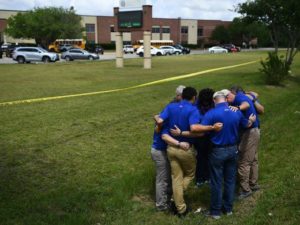
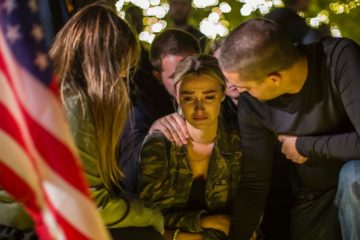
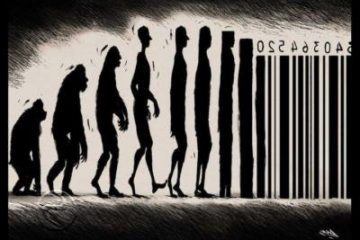



2 Comments
I was in isolation in the hospital for 44 days. I noticed after a few weeks I couldn’t take the violence on TV any more. It was making me sick. I thought I was crazy, but reading what you said makes sense to me.
Thanks, Yes, the onslaught of negativity takes its toll.